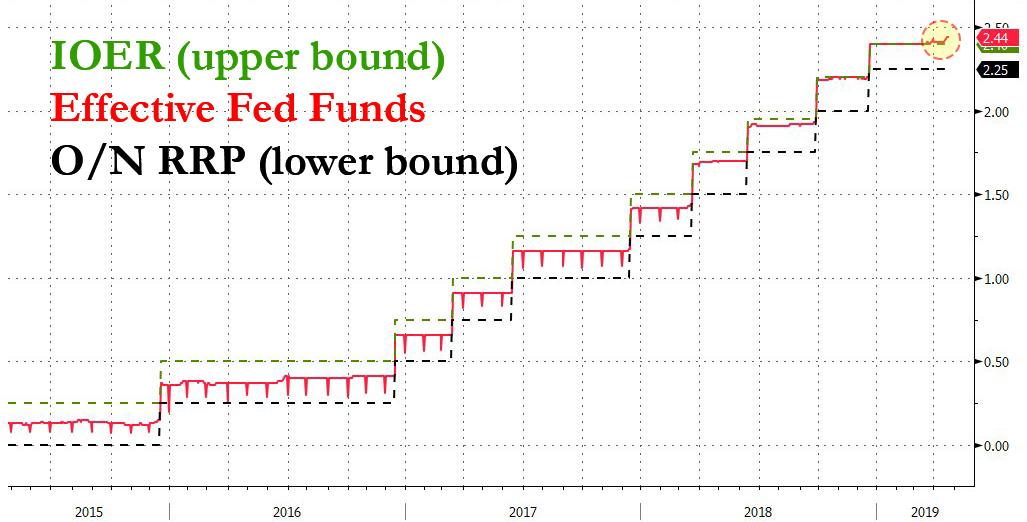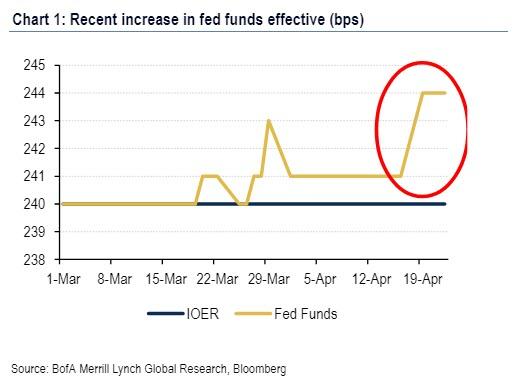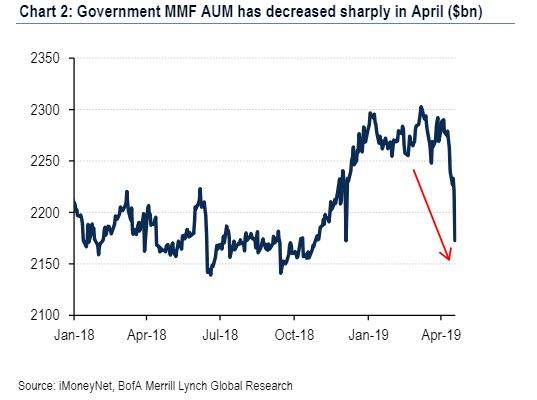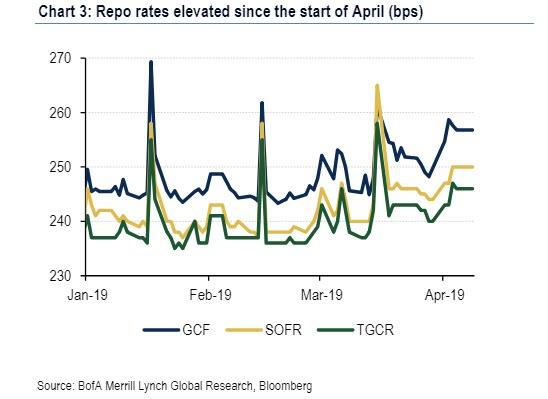Something unexpected has been going on in overnight funding markets: ever since March 20, the Effective Fed Funds rate has been trading above the IOER. This is not supposed to happen.
As a reminder, ever since the financial crisis, in order to push the effective fed funds rate above zero at a time of trillions in excess reserves, the Fed was compelled to create a corridor system for the fed funds rate which was bound on the bottom and top by two specific rates controlled by the Federal Reserve: the “floor” for the corridor was the overnight reverse repurchase rate (ON-RRP) which usually coincides with the lower bound of the fed funds rate, while on top, the effective fed funds rate is bound by the rate the Fed pays on Excess Reserves (IOER).
Or at least that’s the theory. In practice, the effective FF tends to occasionally diverge from this corridor, and when it does, it prompts fears that the Fed is losing control over the most important instrument available to it: the price of money, which is set via the fed funds rate.
Ever since March 20, this fear is front and center because as shown in the chart below, starting on March 20, the effective Fed Funds rate rose above the IOER first by just 1 basis point, and then, last Friday spiked as much as 4 bps above IOER.
Here is the recent action zoomed in:
Again: this should not be happening and has prompted numerous concerns among the analyst community what is going on and why has the Fed – which previously adjusted the IOER specifically to avoid having the EFF trade outside the corridor – lost control of rates so badly.
In its attempt to explain what is going on, BofA rates analyst Mark Cabana wrote overnight that the spike in the fed funds rate is due to to MMF outflows around the April tax date and elevated GC repo rates. That said, Cabana notes that he has “been surprised by the moves and had expected supply cuts to push FF & repo lower.”
Addressing the first point, BofA notes that the higher money market rates “have been driven by sizeable MMF outflows, especially from government funds” as shown in the table below.
While it has not gotten much attention in fund flow circles, the chart below shows that the AUM of government money-market funds has declined $108 billion since the start of April with a sizeable $49 billion outflow between Wednesday and Thursday last week according to iMoneyNet.
According to BofA, these outflows “are mostly tax related as investors either pulled funds to meet tax liabilities or to replenish bank deposits from which tax payments were withdrawn.” Furthermore, these MMF outflows have more than offset the $86bn in bill supply cuts since the start of April and according to Cabana, have likely been the dominant driver contributing to elevated GC repo rates. Indeed, GCF, SOFR, and TGCR spreads to IOER have all averaged 2.5 to 4.5 bps higher in April vs similar periods in Q1.
To Bank of America it was these factors plus the shrunk volumes surrounding Easter holiday trading that led to both lower FF volumes and higher FF prints.
Here Barclays offers a slightly different explanation.
The bank’s rate expert Joseph Abate suggesting that the 3bp rise in fed funds since April 16 “suggests that moments of upward pressure on the rate will become more frequent as bank reserves drop, and changes in the level of reserves now have larger effects on the Fed’s policy target.”
Similar to BofA, Barclays believes that a key culprit behind the move higher in the interest rate are recent tax flows, whereby the Treasury’s tax collections flow directly into its account at the Fed, and as they are deducted from taxpayers’ bank accounts, they drain reserves. To demonstrate this point, the bank points out that last week, the Treasury’s cash balance rose by $124 billion while bank reserves fell by about $122b
To Abate, who believes the recent spike in FF is temporary althoug it may take several days before it normalizes back down to 2.40%/2.41%, there’s also a risk that there may only be a “partial correction” in the fed funds rate given that the market is “extremely lopsided,” since the Federal Home Loan Banks (FHLBs) are the only lender.
More concerning is Abate’s conclusion that the large move also suggests that the banking sector is “nearing the steeply sloping part of the reserve demand curve” which means that “bank reserves are now significantly closer to what individual banks consider their ‘least comfortable level of reserves’ and thus banks are more willing to pay higher rates to retain these balances.”
In other words, some $1.5 trillion in excess liquidity created by the Fed is no longer enough for banks which are starting to scramble to obtain additional liquidity, which needless to say, is very troubling for a banking system which is supposedly “fortress” and “much more stable” than it was before the financial crisis. If anything, this means that even a modest liquidity draining crisis at any point in the future could have vastly more dire consequences than even the pessimists believe.
So what should the Fed do to regain control over interest rates?
According to Barclays to address the expected increase in fed funds volatility, the Fed could either end the balance sheet runoff this summer instead of waiting until September, create a standing repo facility – something which has been rumored for months – or conduct standard open market operations, injecting even more liquidity into the system.
Meanwhile, BofA points out that the recent FF rise has increased speculation the Fed might consider an imminent IOER reduction, possibly at the May meeting next week, even though the bank believes that this is premature for now, and it would likely take FF increasing to and remaining at 2.45% before the Fed seriously considers such a move. Additionally, the Fed would likely also want to give the market advance notices as it has in the past preferred to signal such a move in advance via the minutes. Here it is worth noting that the Nov minutes indicated the Fed might consider an inter-meeting technical IOER adjustment if needed. This suggests the Fed could act quickly to adjust IOER lower but clearer signals of FF at or above 2.45% would be needed to justify such a move.
In other words, the Fed won’t rush to “regain” control of interest rates until it becomes patently obvious to everyone that it has lost control.
via ZeroHedge News http://bit.ly/2IFC3g4 Tyler Durden




